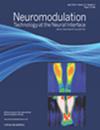Preoperative Magnetic Resonance Imaging Modifies Percutaneous Spinal Cord Stimulator Trial Progression and Planning
IF 3.2
3区 医学
Q2 CLINICAL NEUROLOGY
引用次数: 0
Abstract
Objective
Spinal cord stimulator (SCS) percutaneous lead placement has been effective in treating chronic limb, neck, and back pain. However, SCS lead placement poses a risk of neurologic injury, which may be attenuated with preprocedural magnetic resonance imaging (MRI) to identify potential spinal anatomical abnormalities (eg, central canal stenosis) that would either modify or prevent lead placement. However, a large-scale study of the clinical value of preoperative MRIs in percutaneous SCS lead placement is lacking.
Materials and Methods
A retrospective chart review of a single center identified patients who considered SCS percutaneous lead trials and had preprocedural MRIs. Patients’ preprocedural MRIs were reviewed for spinal pathology and locations and severity of stenoses (mild, moderate, and severe) based on qualitative analysis that may affect lead placement. In addition, trial-related information and several demographic factors were analyzed with proportional analyses, logistic regressions, and relative risks (RR) to determine their association with stenosis.
Results
Retrospective review identified 340 patients who considered an SCS trial with preprocedural MRIs. Preprocedural MRIs influenced SCS treatment for 7% of total patients (n = 25). Of these 25 patients, 60% (n = 15) had the trial technique altered, and 40% (n = 10) did not progress to trial owing to an MRI finding. Preprocedural MRIs were more likely to influence SCS trials for cervical cases than for thoracic/lumbar cases (RR = 4.6, 95% CI 2.2–9.5, p < 0.001). Clinical and demographic characteristics were associated with limited predictive capabilities for spinal stenosis. Specifically, logistic regression analyses revealed age group to be significantly (p ≤ 0.02) associated with moderate/severe cervical spinal stenosis and lumbar spinal stenosis, whereas only age was significantly (p ≤ 0.04) associated with moderate/severe thoracic spinal stenosis.
Conclusion
Preprocedural MRIs did influence SCS trial progression. Given limited patient characteristics were significantly associated with a greater risk of stenosis at lead placement or entry zones, all patient populations should be considered for preprocedural MRIs examining lead entry and placement zones.
术前磁共振成像改变经皮脊髓刺激器试验进展和计划。
目的:脊髓刺激器(SCS)经皮置铅治疗慢性肢体、颈部和背部疼痛是有效的。然而,SCS导联置入存在神经损伤的风险,可以通过术前磁共振成像(MRI)来识别可能改变或阻止导联置入的潜在脊柱解剖异常(如中央椎管狭窄),从而减轻神经损伤的风险。然而,缺乏对术前mri在经皮SCS导线置入中的临床价值的大规模研究。材料和方法:对单个中心进行回顾性图表回顾,确定考虑SCS经皮导联试验并进行术前mri的患者。根据可能影响导联放置的定性分析,回顾患者术前mri检查脊柱病理、狭窄的位置和严重程度(轻度、中度和重度)。此外,通过比例分析、逻辑回归和相对风险(RR)分析试验相关信息和几个人口统计学因素,以确定它们与狭窄的关系。结果:回顾性研究确定了340例术前mri考虑SCS试验的患者。术前mri影响了7%的患者(n = 25)的SCS治疗。在这25名患者中,60% (n = 15)改变了试验技术,40% (n = 10)由于MRI发现而没有进行试验。与胸腰椎病例相比,术前mri更有可能影响颈椎病例的SCS试验(RR = 4.6, 95% CI 2.2-9.5, p < 0.001)。临床和人口学特征与椎管狭窄的有限预测能力相关。具体而言,logistic回归分析显示,年龄与中度/重度颈椎管狭窄和腰椎管狭窄显著相关(p≤0.02),而只有年龄与中度/重度胸椎管狭窄显著相关(p≤0.04)。结论:术前mri确实影响SCS试验进展。考虑到有限的患者特征与铅置入区或入路区狭窄的风险显著相关,所有患者都应考虑在手术前进行mri检查铅置入区和入路区。
本文章由计算机程序翻译,如有差异,请以英文原文为准。
求助全文
约1分钟内获得全文
求助全文
来源期刊

Neuromodulation
医学-临床神经学
CiteScore
6.40
自引率
3.60%
发文量
978
审稿时长
54 days
期刊介绍:
Neuromodulation: Technology at the Neural Interface is the preeminent journal in the area of neuromodulation, providing our readership with the state of the art clinical, translational, and basic science research in the field. For clinicians, engineers, scientists and members of the biotechnology industry alike, Neuromodulation provides timely and rigorously peer-reviewed articles on the technology, science, and clinical application of devices that interface with the nervous system to treat disease and improve function.
 求助内容:
求助内容: 应助结果提醒方式:
应助结果提醒方式:


